-
 Bitcoin
Bitcoin $84,278.9725
-0.42% -
 Ethereum
Ethereum $2,296.3504
-1.69% -
 Tether USDt
Tether USDt $0.9991
0.05% -
 XRP
XRP $2.1772
-0.40% -
 BNB
BNB $601.6772
-1.25% -
 Solana
Solana $136.3518
-0.02% -
 USDC
USDC $0.9999
0.00% -
 Dogecoin
Dogecoin $0.2055
1.05% -
 Cardano
Cardano $0.6393
-1.38% -
 TRON
TRON $0.2274
0.29% -
 Chainlink
Chainlink $15.0150
-1.37% -
 Litecoin
Litecoin $124.9704
0.80% -
 Avalanche
Avalanche $22.1008
0.66% -
 Stellar
Stellar $0.2810
-1.28% -
 Toncoin
Toncoin $3.4297
-1.57% -
 UNUS SED LEO
UNUS SED LEO $9.2281
1.53% -
 Sui
Sui $2.7544
-4.35% -
 Shiba Inu
Shiba Inu $0.0...01432
-0.21% -
 Hedera
Hedera $0.1999
1.37% -
 Polkadot
Polkadot $4.8521
2.05% -
 MANTRA
MANTRA $7.3522
3.42% -
 Hyperliquid
Hyperliquid $20.5480
2.01% -
 Ethena USDe
Ethena USDe $0.9992
0.05% -
 Bitcoin Cash
Bitcoin Cash $295.4055
0.68% -
 Dai
Dai $0.9998
0.00% -
 Bitget Token
Bitget Token $4.1437
3.49% -
 Uniswap
Uniswap $7.8015
-2.29% -
 Monero
Monero $208.6870
-3.21% -
 NEAR Protocol
NEAR Protocol $3.0357
-0.20% -
 Aptos
Aptos $6.0934
1.44%
Withdraw USDT from Ouyi
To initiate a USDT withdrawal from your Ouyi account, navigate to the "Assets" tab, select "USDT," and click the "Withdraw" button to proceed with the withdrawal process.
Jan 24, 2025 at 01:31 pm
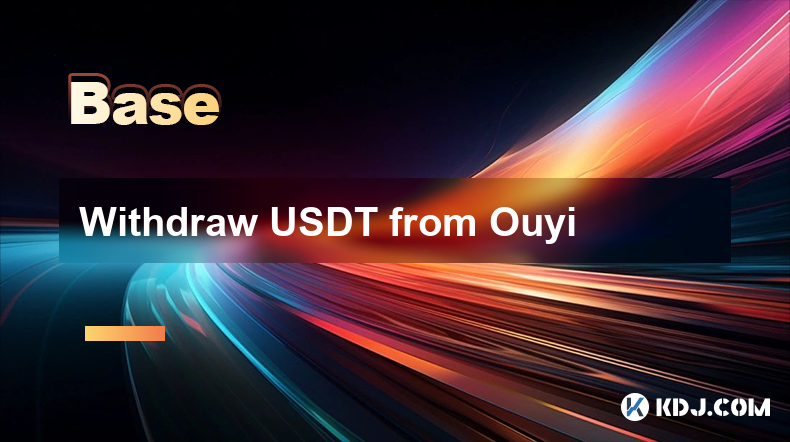
How to Withdraw USDT from Ouyi
Key Points:
- Log into your Ouyi account.
- Navigate to the "Assets" tab.
- Select "USDT" from the list of currencies.
- Click "Withdraw."
- Enter the recipient's wallet address.
- Enter the amount of USDT you wish to withdraw.
- Select the withdrawal network (e.g., TRC-20, ERC-20).
- Review the withdrawal details and confirm the transaction.
Step-by-Step Guide:
1. Log into Your Ouyi Account:
- Visit the Ouyi website (https://www.ouyi.com/) and click "Sign In" in the top-right corner.
- Enter your username and password to log into your account.
2. Navigate to the "Assets" Tab:
- Once logged in, hover over "Assets" in the top menu.
- A drop-down menu will appear. Click "Spot Account."
3. Select "USDT" from the List of Currencies:
- On the "Spot Account" page, scroll down to find "USDT" in the list of currencies.
- Click "USDT" to display your USDT balance and transaction history.
4. Click "Withdraw":
- Locate the "Withdraw" button on the right-hand side of the "USDT" page.
- Click "Withdraw" to initiate the withdrawal process.
5. Enter the Recipient's Wallet Address:
- On the withdrawal form, enter the recipient's USDT wallet address in the "To Address" field.
- Make sure you have selected the correct network (e.g., TRC-20, ERC-20) when entering the wallet address.
6. Enter the Amount of USDT You Wish to Withdraw:
- Enter the amount of USDT you wish to withdraw in the "Amount" field.
- The minimum withdrawal amount varies based on the withdrawal network selected.
7. Select the Withdrawal Network:
- Ouyi supports multiple withdrawal networks for USDT.
- Select the desired withdrawal network (e.g., TRC-20, ERC-20) from the drop-down menu.
- Each network has its own fees and transaction times.
8. Review the Withdrawal Details and Confirm the Transaction:
- Review the withdrawal details carefully, ensuring that the recipient's wallet address, amount, and withdrawal network are correct.
- Click "Confirm Withdrawal" to initiate the withdrawal.
- You may be required to enter a one-time password (OTP) sent to your email or mobile phone for additional security.
FAQs:
Q: What is the minimum withdrawal amount for USDT on Ouyi?
A: The minimum withdrawal amount for USDT on Ouyi varies based on the withdrawal network selected. Generally, the minimum withdrawal amount is:
- TRC-20: 1 USDT
- ERC-20: 25 USDT
Q: What are the withdrawal fees for USDT on Ouyi?
A: Ouyi charges different withdrawal fees depending on the withdrawal network selected. The current withdrawal fees for USDT are:
- TRC-20: 1 USDT
- ERC-20: 3 USDT
Q: How long does it take to withdraw USDT from Ouyi?
A: The withdrawal processing time varies based on several factors, including network congestion and the specific withdrawal network selected. Typically, withdrawals take:
- TRC-20: Less than 1 hour
- ERC-20: 2 to 4 hours
Disclaimer:info@kdj.com
The information provided is not trading advice. kdj.com does not assume any responsibility for any investments made based on the information provided in this article. Cryptocurrencies are highly volatile and it is highly recommended that you invest with caution after thorough research!
If you believe that the content used on this website infringes your copyright, please contact us immediately (info@kdj.com) and we will delete it promptly.
- Bitcoin Price Likely to Hit $81k Says Analyst While This Altcoin Rises 234x in Days
- 2025-02-28 09:15:33
- Ripple's altcoin XRP falls 0.95% on February 27th, with weekly and monthly timeframes revealing a not-so-optimistic outlook.
- 2025-02-28 09:15:33
- Ripple Releases Its 2025 Strategic Development Plans, Focusing on Enhanced Institutional DeFi and Lending
- 2025-02-28 09:15:33
- Web3Bay Presale Soars Past $1.54M as Bitcoin Drops to $95,000
- 2025-02-28 09:10:33
- Seeking high-growth cryptos in this market chaos? Bitcoin, XRP, and other cryptocurrencies tried to recover early Thursday
- 2025-02-28 09:10:33
- Bitcoin (BTC) Exchange-Traded Funds (ETFs) Offering Staking Capabilities Could Significantly Boost Institutional Engagement
- 2025-02-28 09:10:33
Related knowledge
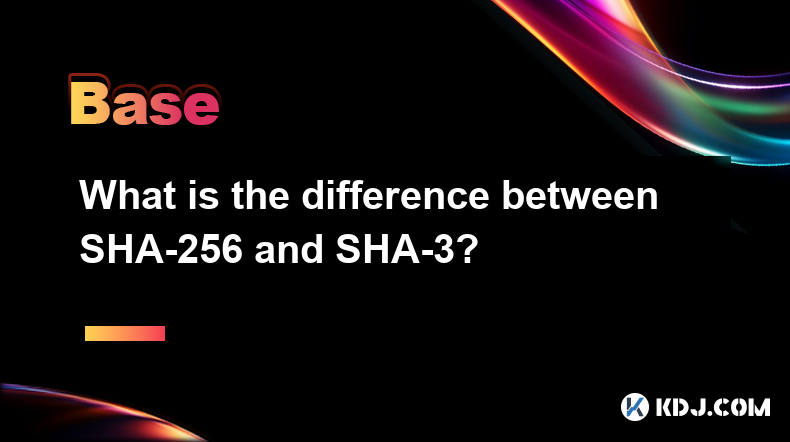
What is the difference between SHA-256 and SHA-3?
Feb 27,2025 at 07:37pm
What is the difference between SHA-256 and SHA-3?Key Points:SHA-256's Design and Security: SHA-256, part of the SHA-2 family, is a widely used cryptographic hash function based on a Merkle–Damgård construction. Its security relies on the assumed difficulty of certain mathematical problems. While it hasn't been demonstrably broken, ongoing research and t...

What are the common hash algorithms?
Feb 28,2025 at 02:06am
What are the Common Hash Algorithms? A Deep Dive into Cryptographic Hash FunctionsKey Points:This article explores various common hash algorithms used in the cryptocurrency space, detailing their functionalities, strengths, weaknesses, and applications.We will delve into the specifics of SHA-256, SHA-3, Scrypt, Blake2b, and Keccak-256, explaining their ...
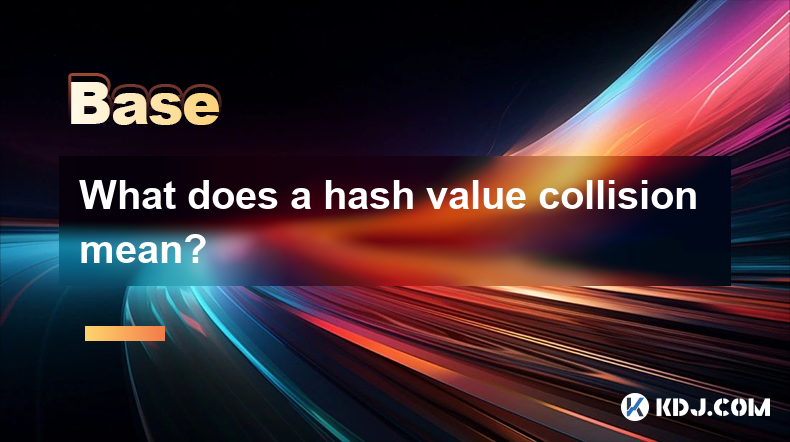
What does a hash value collision mean?
Feb 28,2025 at 12:18am
What Does a Hash Value Collision Mean? A Deep Dive into Cryptographic Hashing and its ImplicationsKey Points:A hash collision occurs when two distinct inputs produce the same output hash value. This is a critical vulnerability in cryptographic systems relying on hash functions for data integrity and security.The likelihood of a collision depends on the ...
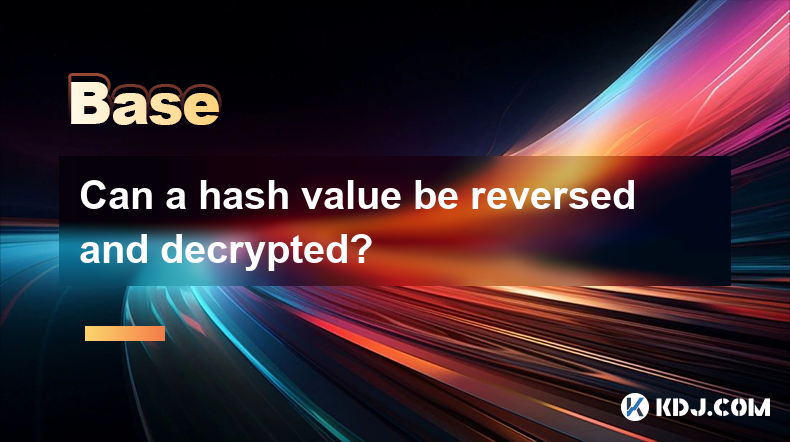
Can a hash value be reversed and decrypted?
Feb 27,2025 at 06:00pm
Can a Hash Value Be Reversed and Decrypted?Key Points:Hash functions are one-way cryptographic functions; reversing a hash to obtain the original input is computationally infeasible.While technically not impossible, reversing a hash requires an immense amount of computational power and time, making it practically impossible for all but the shortest and ...
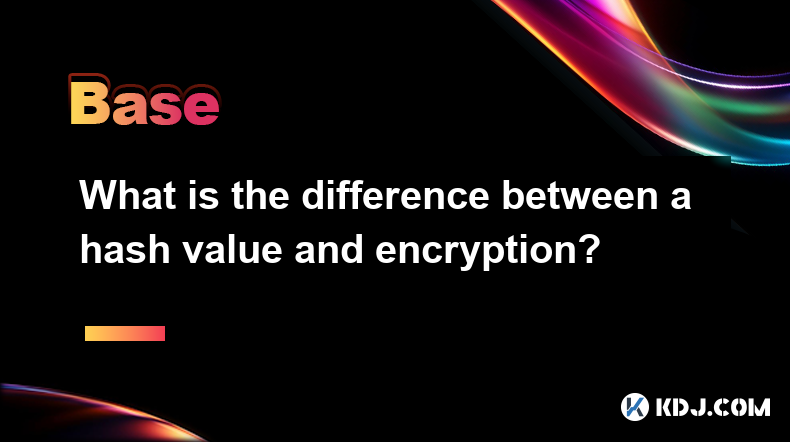
What is the difference between a hash value and encryption?
Feb 27,2025 at 08:01pm
What is the difference between a hash value and encryption?Key Points:Hashing: A one-way function producing a fixed-size output (hash) from any input, ensuring data integrity but not confidentiality. It's crucial for blockchain technology's security.Encryption: A two-way process involving an algorithm and a key to transform readable data (plaintext) int...
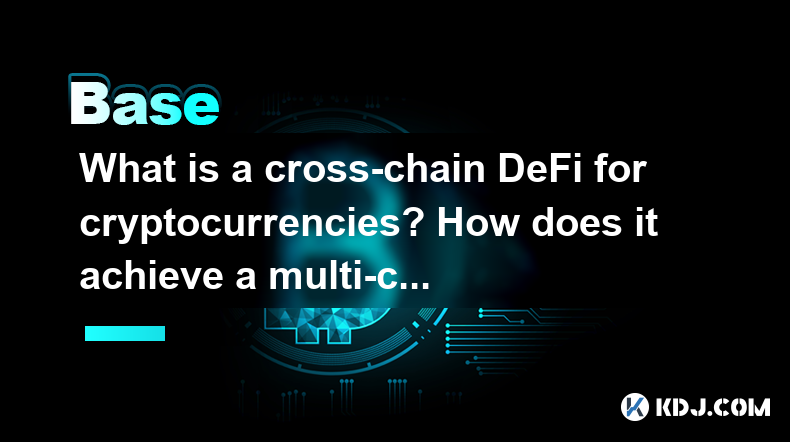
What is a cross-chain DeFi for cryptocurrencies? How does it achieve a multi-chain financial ecosystem?
Feb 26,2025 at 11:24pm
What is a Cross-Chain DeFi for Cryptocurrencies? How Does it Achieve a Multi-Chain Financial Ecosystem?Key Points:Definition of Cross-Chain DeFi: Cross-chain DeFi refers to decentralized finance (DeFi) applications and protocols that operate across multiple blockchain networks, enabling interoperability and bridging the gaps between isolated ecosystems....

What is the difference between SHA-256 and SHA-3?
Feb 27,2025 at 07:37pm
What is the difference between SHA-256 and SHA-3?Key Points:SHA-256's Design and Security: SHA-256, part of the SHA-2 family, is a widely used cryptographic hash function based on a Merkle–Damgård construction. Its security relies on the assumed difficulty of certain mathematical problems. While it hasn't been demonstrably broken, ongoing research and t...

What are the common hash algorithms?
Feb 28,2025 at 02:06am
What are the Common Hash Algorithms? A Deep Dive into Cryptographic Hash FunctionsKey Points:This article explores various common hash algorithms used in the cryptocurrency space, detailing their functionalities, strengths, weaknesses, and applications.We will delve into the specifics of SHA-256, SHA-3, Scrypt, Blake2b, and Keccak-256, explaining their ...

What does a hash value collision mean?
Feb 28,2025 at 12:18am
What Does a Hash Value Collision Mean? A Deep Dive into Cryptographic Hashing and its ImplicationsKey Points:A hash collision occurs when two distinct inputs produce the same output hash value. This is a critical vulnerability in cryptographic systems relying on hash functions for data integrity and security.The likelihood of a collision depends on the ...

Can a hash value be reversed and decrypted?
Feb 27,2025 at 06:00pm
Can a Hash Value Be Reversed and Decrypted?Key Points:Hash functions are one-way cryptographic functions; reversing a hash to obtain the original input is computationally infeasible.While technically not impossible, reversing a hash requires an immense amount of computational power and time, making it practically impossible for all but the shortest and ...

What is the difference between a hash value and encryption?
Feb 27,2025 at 08:01pm
What is the difference between a hash value and encryption?Key Points:Hashing: A one-way function producing a fixed-size output (hash) from any input, ensuring data integrity but not confidentiality. It's crucial for blockchain technology's security.Encryption: A two-way process involving an algorithm and a key to transform readable data (plaintext) int...

What is a cross-chain DeFi for cryptocurrencies? How does it achieve a multi-chain financial ecosystem?
Feb 26,2025 at 11:24pm
What is a Cross-Chain DeFi for Cryptocurrencies? How Does it Achieve a Multi-Chain Financial Ecosystem?Key Points:Definition of Cross-Chain DeFi: Cross-chain DeFi refers to decentralized finance (DeFi) applications and protocols that operate across multiple blockchain networks, enabling interoperability and bridging the gaps between isolated ecosystems....
See all articles

















































































